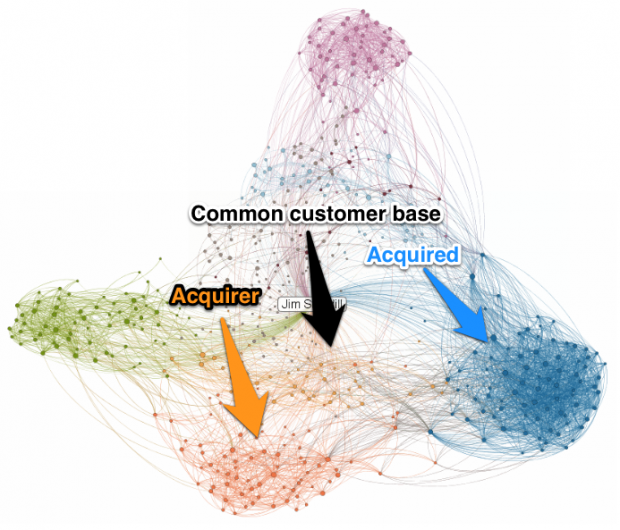I finally got around to looking at my personal network graph on Linkedin Labs the other day. It was a fun exercise and I got at least one interesting insight from it.
Take a look at these two well defined and distinct clusters in my graph. These are my connections with the startup I worked for (blue) and the company that acquired us in 2008 (orange). It is fascinating to me that all these years later the clusters remain so disconnected. There are shared connections within a common customer base, but very few direct connections across the clusters. I would love to see maps from some of my other colleagues who are still there to see if theirs show the same degree of separation. This was an acquisition that never really seemed to click and whether this is a picture of cause or effect, it maps to my experiences living in it.
That’s an aside though. What this graph really puts in stark relief is what every social network out there is learning about us. And this graph doesn’t really tell the whole story because it doesn’t represent edge weights and types, which they also know. Social networks know who we connect with, who we interact with, and the form and strength of those interactions.
But this post isn’t a privacy rant. I know they know this stuff and so do you. What this image got me thinking about again is why social networks aren’t using this information to create for us a social experience that is more like our real world, and frankly more in tune with our human-ness.
Social media properties plumb this data to know which ads to show us, and sometimes they use it to target messages to us more effectively. Remember those LinkedIn messages we got with the pictures of our friends? We all clicked on them. But they just don’t seem to be making that much effort to make use of what they know to innovate on our behalf, to improve our experience.
For example, Facebook knows all of this too and yet they continue to cling to the curious fiction that our social life is one giant flat maximally-connected equi-weighted graph. A single giant room where we all stand shoulder to shoulder wondering who all of these strangers are. A place that refuses to acknowledge the nuance and complexity of our real world relationships. And Twitter, for all it’s wonderfulness, does the same thing. And Google Plus? Why are you making me curate circles? You know what they are. At least take a guess at making them for me.
They call themselves social networks, but in terms of how they express themselves to us, their users, they seem to be using the word “network” the way broadcast television does. The experience is more analogous to a vast mesh of public access television networks than with the complexity and richness of real world social connections. You say something and it is presented to everyone, no matter which of those clusters they inhabit. So 10% care and the rest of them filter it.
In the natural world of human-to-human conversation, communication travels person to person, modified and attenuated along the way. Or, in some cases, amplified into a cluster-spanning meme. I think it would be fascinating to see social media properties experiment with recreating some of these more complex dynamics. What if I could “talk” to a well-defined cluster in my graph and see the strength of the signal attenuate rapidly as the distance from that core increased? Not to make it invisible, but perhaps make its volume more appropriate to the another cluster’s contextual center of gravity.
Or, in the inverse, knowing things about my graph Twitter could give me a really nice low-pass filter that gave preference to those in my stream that are “close” to me, or share a common edge type, but who might not be tweeting at high frequency.
There are lots of possibilities along these lines. And I know that a big part of what makes these services useful is their simplicity. Fine. But ultimately, I wonder is all of this network science going to benefit me in any direct way as a user of these services, or is the whole field of data science ultimately about reverse engineering me for sake of advertisers?
I wrote a post a while back about our paleolithic roots and the way we consume media. The “diet” part aside, what I’ve been thinking about a lot since is a digital design sense that caters to our neurological reality. Instead of designing for the convenience of the machines and demand that we adapt, design for who we actually are. Buggy. Tribal. Easily distracted. Full of bias. Curious. Whatever. I’m eager to see a more ambitious approach to design that infuses our digital worlds with more of the nuance and subtlety we find in the physical realm, all while preserving the reach that makes our digital world special.

